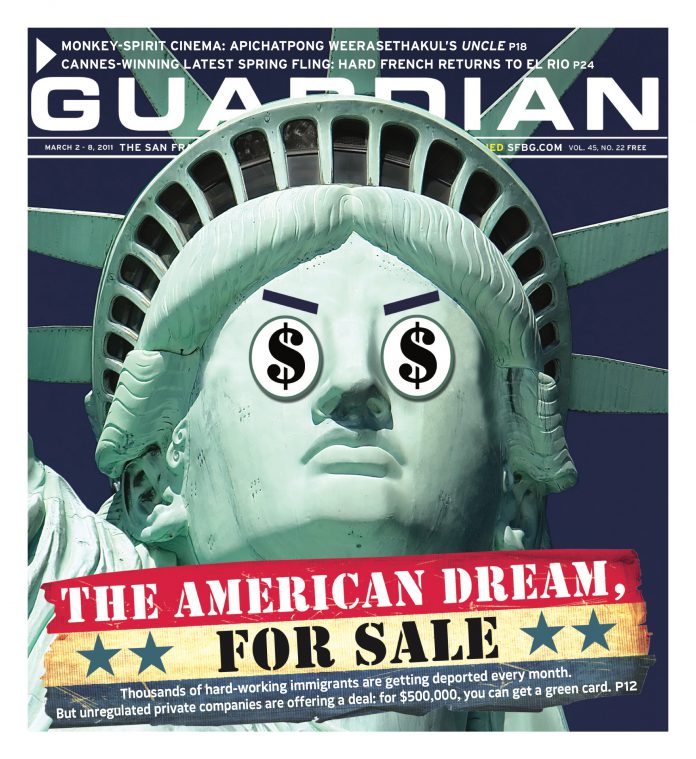paulr@sfbg.com
DINE When Absinthe opened in Hayes Valley in 1998, it was meant to evoke an aura of Provence. Meanwhile, the restaurant’s name carried a whiff of naughty Parisian excitement. Absinthe was the grog Oscar Wilde drank himself to death with in the French capital after his release from Reading Gaol, and not too many years later it was banned in France (and here) on suspicion that, like masturbation, it caused blindness and insanity.
These days, absinthe is enjoying a small revival, having largely been exonerated of its devil’s-brew reputation. And the restaurant — which, along with Jardinière, represented revival in a part of town unsettled for years by contentious freeway demolitions and the symphony strike that began in December 1996 — has not only thrived but settled into an identity it might have been meant to have all along. If you’re a latecomer and you want some sense of what Stars was like back in its heyday in the late 1980s and early 1990s, you’ll find a taste of it at Absinthe. The restaurant offers a bit of the old feel: hints of low-key elegance and even glamour, a look both established and fresh that combines the sunny Mediterranean and the fog-bound, gleaming city, and exemplary food (emerging from a kitchen now run by Adam Keough) that brings together a world of influences into a distinctively Californian balance.
New high-profile restaurants in the city tend not to be like Absinthe. They are often hard-edged, spare, and cold, concocted from glass, steel, and plastic. And they are noisy. Fair enough. But Absinthe, to my mind, is the height of what San Francisco restaurants were, and were like, before the city became a suburb of Silicon Valley. It is a credit to the owner, Billy Russell-Shapiro (who ran the wonderful Rosmarino near Laurel Village before launching Absinthe) that he has let his restaurant evolve into Stars’ successor, or dauphin, without renaming it or otherwise clumsily tinkering with it. Evolution is undervalued, I would say, in our revolution-worshipping culture — tear it down, throw them out, get a new one — but evolution is how most real change is achieved.
Keough’s menu does retain some definite Provençal trappings, although — since these sorts of trappings are typical of a lot of the rustic-Mediterranean cooking that’s the foundation of California cuisine — they tend to enhance one’s sense that the style is distinctively Absinthe’s and not a dutiful attempt to recreate old dishes from the other side of the world as if from Nonna’s recipe book. The berbere-spiced fried chickpeas ($4) were not only addictive but the kind of thing you might find in a restaurant near the old quay in Marseilles.
The fabulous garlic pretzels ($7), on the other hand, like a cord of thumb-sized fire logs ready for dipping in a mornay sauce of Vermont cheddar, could have been a witty take on Oktoberfest. And the marvelous potato tart (a bit pricey at $14) had a distinctive northern, even wintry, flair, with its leeks, egg, long length of crispy smoked bacon, and large effusion of frisée on the side.
If any dish is supremely characteristic of Provence, it would have to be the seafood stew called bouillabaisse, and Keough does serve up a lovely version ($15). It’s listed with the share plates, but it’s plenty big enough to be a main course unless you’re ravenous or a carnivore. The stew was chockablock with manila clams and PEI mussels, along with a huge sea scallop, a beguiling broth of puréed red-bell peppers scented with garlic and bacon, and, on the side, levain toasts spread with an ebullient herb rouille. The stew did not seem to have been finished with pastis, the French version of the anise-flavored liquor that’s ubiquitous around the Mediterranean, but the bacon’s tang was a worthy alternative.
Speaking of worthy: a skirt steak ($24) that was actually tender as well as tasty. The meat was served with black-garlic mashed potatoes (black garlic being fermented and slightly sweet), which were not in fact black, more of a caramel color, but still dramatic. Less dramatic but important in supporting roles were a green-peppercorn jus and braised artichokes.
No sweet confection has ever disappointed me more than German chocolate cake. Despite Germany’s formidable reputation in chocolate, German chocolate has long seemed unpersuasive, and it isn’t even the right color. Absinthe’s version ($9) did have the fearsome hepatic pallor, but it was layered with crushed almonds, capped with dollops of coconut-like foam (like little meringues), festooned with candied walnuts, and altogether had a complex, not-too-sweet chocolatiness even a skeptic could love.
ABSINTHE
Tues.–Fri., 11:30 a.m.-midnight;
Sat., 11.a.m.–midnight; Sun., 11 a.m.–10 p.m.
398 Hayes, SF
(415) 551-1590
Full bar
AE/DC/DS/MC/V
Well-managed noise, but not quiet
Wheelchair accessible

